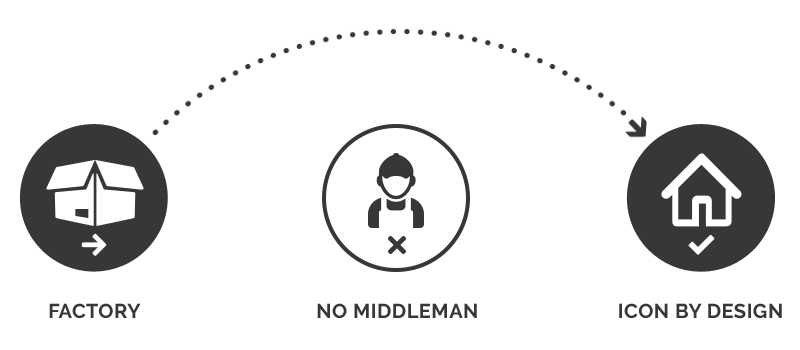Timeless Design: Part IV – The Mini

There are few cars in the history of automobile design that can claim a lack of deviation from their original form. The Mini is one of them. Voted the second most influential car of the 20th century (behind the Ford Model T – generally regarded as the first ever automobile), its popularity has remained unwavered since its conception in the late 1950s. So, what does the Mini owe this popularity to? How has a car managed to capture the imagination of a global population for over 60 years? In the final part of our Timeless Design series, we’ll take a look at how the Mini executes the first three elements of timeless design, yet owes its iconic status to a fourth and final: contentment.
In the first three parts of this series, we discussed how practicality, simplicity, and craftsmanship play crucial roles in designing for longevity. The Mini started its life as a practical solution to an oil shortage plaguing the UK in the late 1950s; a response to the Suez Canal crisis in 1956 which saw a major part of Britain’s oil route cut off. Revered automobile designer Sir Alec Issigonis was engaged to spearhead a project for BMC (British Motor Company); conceptualising a “proper miniature car” that would both rival the other ‘bubble cars’ on the market at the time (most notably the Fiat 500) and make driving more economical for British motorists. Issigonis’s task was not an easy one; several requirements had to be met with the car’s design: the car had to fit within a box that measured 10 x 4 x 4 feet (roughly 3 x 1.2 x 1.2 metres), with the cabin of the car occupying at at least 60% of that. To achieve this, Issigonis had a ‘eureka’ moment; deciding to mount the engine transversely at the front of the car – simultaneously saving space, and providing a steadier centre of gravity for the driver (subsequent smaller car designs have followed this revolutionary solution almost without exception).
To produce an economical car – both in terms of fuel, and the cost of the car itself – simplicity was key when designing the interior of the Mini. A centre-mounted speedometer (which has become one of the most-loved features of the Mini) saved space behind the steering wheel; small wheels, positioned at the corners of the car, also enlarged the compartment. The remainder of the interior was stripped back to its bare essentials – indeed, side mirrors, seat belts, a radio, and heater were ‘optional extras’, added at a cost! Despite BMC’s ‘no-frills’ attitude, the materials used in construction were top of the line; a steel subframe supported a light monocoque shell. Monocoques are “specifically designed to crumple in the event of a collision and absorb energy, protecting the occupants from the full force of the crash.” It’s therefore no surprise that after its release in 1959, “a race car builder named John Cooper approached BMC with the intention of altering a Mini into a viable race car.” The result of this partnership was the first Mini Cooper, released in 1962, a car that “won multiple races, including three victories at the Monte Carlo Rally.”
It was certainly a combination of practicality, simplicity, and craftsmanship that resulted in the initial success and popularity of the Mini. Its diversity meant that it appealed to a mass market; it was embraced by families, race-car enthusiasts, teenagers, celebrities, and everyone in-between, becoming an icon of the ‘Swinging 60s’ and a beacon of British design. But ask a Mini owner why they bought the car, and it’s most likely they won’t mention any of the ‘fundamental elements’ first. It’s the enjoyment they get from driving it. The mechanics of the Mini gave it “go-kart like handling”; resulting in an exhilarating driving experience. Its low centre of gravity allowed the driver a ‘connection’ with the road that was unparalleled. I’d argue, however, that it’s the face-like features – almost comical, but instantly recognisable – that contribute as much joy to the driver, as to the beholder, of the car. The Mini encourages a smile; it’s emotive, personable, and playful. Contentment is what makes it timeless.
Design that produces an emotional reaction is the strongest element of them all. Contentment gives a product a life; it allows it to be treasured, enjoyed, loved. When founding Icon By Design in 2015, this emotional connection was integral to our business model – not just in terms of our products, but in all elements of our business. The decision to use only sustainably sourced, solid timbers was deliberate; it’s very hard to form an emotional connection with MDF and veneer – solid timber is a living, breathing material. Our designs are consciously created with timelessness in mind – we want our customers to remember why they purchased 10, 20, 30+ years from now through the positive associations made by incorporating our products into their home. Lastly, a customer’s experience with our brand is as important to us as the product itself. That’s why we go above and beyond to serve our customers. It’s this ‘magic ingredient’ that differentiates us from our competitors – you only have to read our customer reviews to see the difference it makes.
Our charismatic Franz Armchair in Sage Green and Cinnamon Stain Solid Oak.
Through four iconic products – the Anglepoise Lamp, the iPod, the Burberry Trench Coat, and the Mini – we’ve examined the four key elements of timeless design. Practicality must be a product’s foundation – it must execute its intended purpose. Simplicity – it must be instinctively easy to use. In order to physically last, Craftsmanship must play an integral role – it must be made well, with materials that can stand the test of time. Lastly, Contentment is what makes you want to buy the product – it’s the positive and emotive reaction to the first three elements. To see how Icon By Design incorporates all these elements into our timeless designs, visit our website, or experience the Icon Difference in-store.
Recent Posts
-
1
-
2
-
3
-
4
-
5
-
6
-
7
-
8
-
9
-
10






 1300 715 719
1300 715 719 Showrooms
Showrooms





















